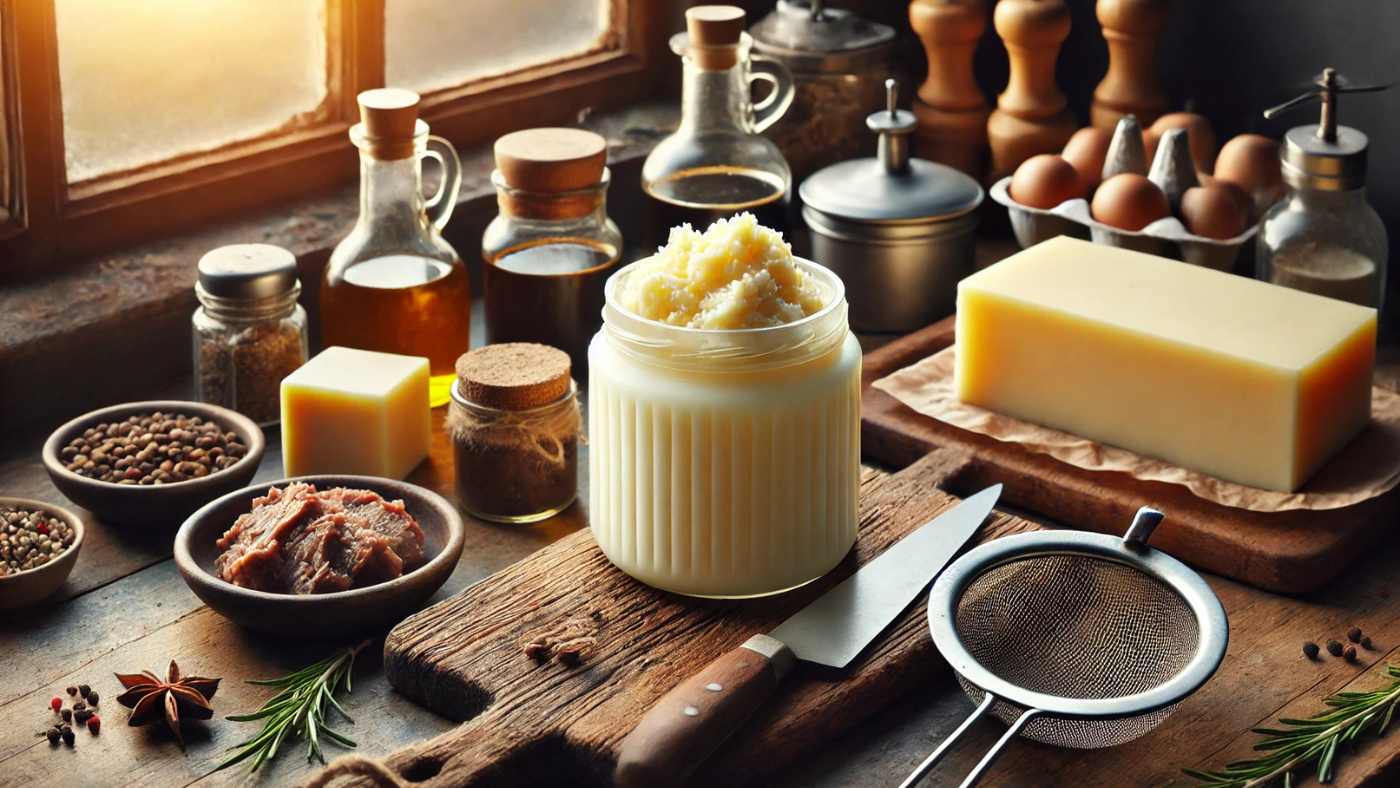Beef Tallow Flavor Profile: What It Really Tastes Like

Beef tallow flavor profile is a phrase that’s getting a lot more attention lately—and for good reason.
After decades of being pushed aside for industrial seed oils and butter substitutes, this traditional fat is making a bold return.
But what does beef tallow actually taste like?
Is it beefy?
Is it greasy?
Is it just bland?
The short answer is—it’s rich, savory, and surprisingly clean.
And the long answer?
That’s exactly what you’ll uncover in this guide.
Whether you’re curious about adding beef tallow to your cooking routine or just exploring real food alternatives, this article will walk you through its flavor, cooking performance, comparisons, and more. From searing steaks to roasting vegetables, the versatility of beef tallow will inspire you to experiment in the kitchen.
Let’s dive into this forgotten fat with flavor worth rediscovering.
What Is Beef Tallow and Why Is It Making a Comeback?
Beef tallow is rendered beef fat—specifically, the hard fat that surrounds the kidneys and loins.
It’s been used for centuries by cultures around the world for cooking, preserving, and skincare.
Before the rise of processed oils, tallow was the go-to fat in home kitchens and even fast food fryers.
So why did we stop using it?
In the mid-20th century, saturated fat became public enemy number one (1).
Misinformation campaigns—combined with the rise of hydrogenated vegetable oils—pushed natural fats like tallow off our plates.
But today, the tables are turning.
Thanks to the rise of ancestral eating, paleo, and carnivore diets, tallow is getting a second look.
Health-conscious consumers are realizing the value of real, whole fats, and tallow fits the bill.
Plus, it’s sustainable when sourced from grass-fed cattle and helps reduce food waste by using the whole animal.
Wild Foods believes in reWilding your plate—and beef tallow is the kind of ancient nourishment that helps you do just that.

The True Beef Tallow Flavor Profile: Taste, Texture, and Aroma
So, what does beef tallow really taste like?
In one word: clean.
Despite being a beef product, tallow doesn’t taste overtly meaty.
High-quality, properly rendered tallow has a neutral to mildly savory flavor.
It’s less buttery than ghee and far less pronounced than bacon fat.
Here’s how most people describe its sensory profile:
-
Taste: Subtle umami, lightly beefy, not greasy or overpowering
-
Texture: Smooth and silky when melted, slightly waxy when solid
-
Aroma: Mild scent that disappears during cooking
Tallow’s flavor is also heavily influenced by how it’s made.
If rendered at low heat (dry rendering), it retains a cleaner and less gamey flavor.
Wet rendering can produce a stronger beef smell and taste—this version is less common in culinary use.
Grass-fed tallow tends to taste fresher and purer than grain-fed tallow due to the animal’s natural diet.
In essence, tallow adds richness and depth without masking the natural flavors of your food.

Beef Tallow vs Butter, Lard, and Vegetable Oils: Flavor Faceoff
If you’re wondering how beef tallow stacks up against butter or other fats in terms of flavor, you’re not alone.
Let’s break it down:
-
Butter: Buttery, creamy, and slightly sweet—adds character but can burn quickly
-
Lard: More pork-forward flavor, slightly earthier than tallow
-
Vegetable oils: Neutral but flat, no flavor enhancement, and highly processed
-
Tallow: Subtle, savory richness that enhances flavor without stealing the spotlight
Tallow’s high smoke point (around 400°F) makes it ideal for searing and frying.
Unlike butter, which browns and burns easily, tallow holds strong under heat.
It crisps food beautifully while infusing it with just a hint of savory richness.
In flavor-sensitive dishes like eggs or roasted vegetables, tallow can actually highlight natural flavors better than butter or oil.
It’s the invisible flavor upgrade you didn’t know you needed.
How Beef Tallow Enhances Food: From Steak to Frying
Chefs and foodies are falling in love with beef tallow all over again.
Why?
Because it turns simple ingredients into crave-worthy bites.
Here’s where beef tallow really shines:
-
Steak searing: Forms a rich crust and keeps the meat juicy
-
Frying: Golden, crisp texture with no greasy aftertaste
-
Roasted vegetables: Brings out deep, earthy flavors
-
Eggs: Clean sizzle and rich mouthfeel without oil slick
-
Homemade fries: Authentic old-school taste with perfect crunch
In fact, many people say once you fry in beef tallow, there’s no going back.
It’s how fast-food chains used to do it—before switching to processed oils.
And if you’re grilling or roasting meat, basting with tallow keeps things moist and flavorful.
This isn’t just cooking fat—it’s a flavor amplifier.

Is Beef Tallow Healthy? Myths, Benefits, and Real Talk
There’s still a lingering fear around saturated fats, but it's largely outdated.
Beef tallow is rich in stable, natural fats that support hormone production, brain function, and satiety. Knowing that you're getting these health benefits with high-quality beef tallow can reassure you about your food choices (2).
Here’s what you’re really getting with high-quality beef tallow:
-
Rich in vitamins A, D, E, and K2 (especially from grass-fed cows) (3)
-
Contains conjugated linoleic acid (CLA), which may support metabolism
-
Free from inflammatory seed oils and artificial additives
-
Supports nutrient absorption and blood sugar regulation
Contrary to popular belief, saturated fat from real food doesn’t cause heart disease (4).
The real culprits? Refined carbs and oxidized seed oils.
Using beef tallow instead of canola or soybean oil is a smart step toward a more natural, ancestral diet.
And for your skin?
Tallow’s fatty acid structure is incredibly close to human sebum, making it ideal for skin nourishment (5).
Wild Foods even uses tallow in select skincare formulations because of its natural compatibility with your body.
How to Make and Store Beef Tallow for Best Flavor
Want to try beef tallow for yourself?
You can make it at home with just a few simple steps:
-
Get grass-fed beef suet or trimmings from a butcher
-
Chop finely or grind for even rendering.
-
Heat gently over low heat in a heavy pot
-
Strain through cheesecloth into a clean jar.
-
Let cool and store in a cool, dark place.ce
Properly rendered tallow is shelf-stable and doesn’t require refrigeration (though it will last longer in the fridge).
Always store in glass jars with tight lids.
Avoid moisture, as it can cause spoilage.
If your tallow smells sour or rancid, toss it—it should have a clean and faintly savory aroma.
Wild Foods offers 100% grass-fed beef tallow sourced from small farms—perfect for those who want the flavor without the hassle of rendering it themselves.
Final Thoughts
Beef tallow isn’t just a relic of the past—it’s a culinary and nutritional powerhouse making a well-deserved comeback.
With its savory, clean flavor profile, tallow brings real depth to everyday meals—from sizzling steak to crispy roasted veggies.
It’s more than just fat—it’s ancestral nourishment that aligns with Wild Foods’ mission to reWild your health.
So if you’ve been stuck in a butter rut or drowning in seed oils, maybe it’s time to try something timeless.
Start small.
Swap out your usual oil for beef tallow in your next sauté or sear.
Taste the difference.
Feel the difference.
And when you’re ready to go all in, grab a jar of Wild Foods' premium grass-fed tallow and experience what real flavor—and real food—are all about.
🔥 Elevate your cooking with pure Beef Tallow—grab yours today! 🔥
FAQs
What does beef tallow taste like?
Beef tallow tastes mildly savory and rich with a clean finish. It's not overpowering and adds depth without greasiness. This unique flavor profile will surely intrigue your taste buds.
Does beef tallow taste better than butter?
It depends on the dish. Tallow is better for high-heat cooking due to its neutral, meaty richness. Butter offers more sweetness and nuttiness, but burns easily.
What affects the flavor of beef tallow?
Flavor varies based on cow diet, rendering method (dry vs wet), and how it’s stored. Grass-fed beef yields cleaner-tasting tallow.
Is beef tallow good for frying?
Yes. It has a high smoke point and creates crispy textures with less oil absorption compared to seed oils.
Why did people stop using beef tallow?
Tallow fell out of favor due to the rise of hydrogenated oils and anti-saturated fat campaigns in the mid-20th century, not because it wasn’t healthy or tasty.
Related Studies
Title: Dietary Fats and Cardiovascular Disease: A Presidential Advisory From the American Heart Association
This 2017 advisory from the American Heart Association details how dietary guidelines shifted to recommend limiting saturated fats due to early observational studies, highlighting the historical context of misinformation and the rise of hydrogenated oils.
Link: https://www.ahajournals.org/doi/10.1161/CIR.0000000000000510
Title: Dietary Saturated Fat and the Regulation of Hormones and Appetite
This study investigates how saturated fatty acids influence hormone production and brain function, supporting improved satiety and metabolic regulation.
Link: https://pubmed.ncbi.nlm.nih.gov/23899633/
Title: USDA FoodData Central: Beef, Tallow, Raw
This database entry provides the detailed nutrient profile of beef tallow, including fat-soluble vitamins such as A, D, E, and K, and fatty acid content including conjugated linoleic acid (CLA).
Link: https://fdc.nal.usda.gov/fdc-app.html#/food-details/173938/nutrients
Title: Saturated Fat and Cardiovascular Disease: Reassessing the Evidence
This NIH-funded review analyzes the current evidence and concludes that saturated fat’s role in heart disease is more complex and less direct than once thought, emphasizing the influence of other dietary factors such as refined carbohydrates.
Link: https://www.ncbi.nlm.nih.gov/pmc/articles/PMC5466930/
Title: Fatty Acids in Human Skin Sebum: Composition and Implications for Skin Health
This dermatological study explains the fatty acid profile of human sebum and discusses how animal fats like tallow, which share similar fatty acids, can support skin barrier function and hydration.
Link: https://www.ncbi.nlm.nih.gov/pmc/articles/PMC5849438/
